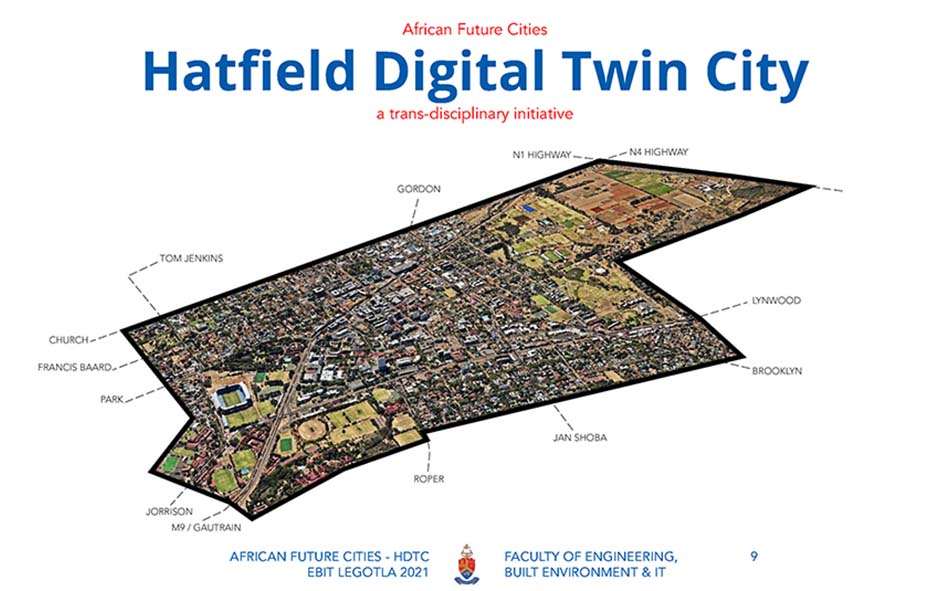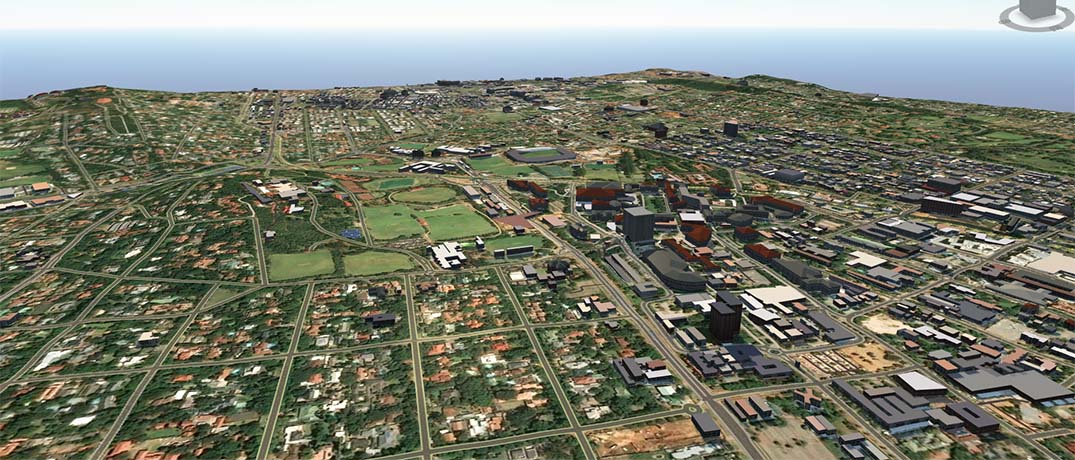The University of Pretoria (UP) has created the Hatfield Digital Twin City, a new initiative that aims to boost service delivery with the help of smart technology.
“In making cities smarter and future fit, we need instruments to help our cities become more efficient – one such instrument is a digital twin: a smart 3D or digital mirror of the city,” says postdoctoral research associate Dr Calayde Davey of UP’s Department of Architecture in the Faculty of Engineering, Built Environment and Information Technology.
“We are focusing on African digital twin cities. In October 2020, we started with the Hatfield Digital Twin City (HDTC) – a 10-square kilometre urban area surrounding UP’s main campus,” Dr Davey explains. “The goal of the digital twin city is to provide real-time virtual models of the urban fabric (streets, buildings, infrastructure, etc) along with real-time resource flows of the physical workings of the city based on monitoring, mapping and tracking information from digital sensors and communication technologies. These are used to improve the services, environments, infrastructure, performance, industry, social and health objectives of cities.”
Professor Chrisna du Plessis, chair of the School of the Built Environment and head of the Department of Architecture, offers the example of electricity management in the vision for future cities. “In the HDTC, we aim to have a detailed smart grid of the entire precinct’s electricity consumption. There are office buildings where electricity is used predominantly during the day, and you have buildings such as blocks of flats where the highest electricity use is at night. This empowers the municipality to shift electricity capacity to where and when it is needed most, and therefore to optimally manage energy consumption.”
In the same vein, the digital twin city can be used to track and manage food supply flow, traffic flow, water quality and quantity, air quality, public health, disease detection, crime, biodiversity conservation, homelessness, urban development, how well buildings are performing in terms of energy and water use, but also in terms of profit, business and industry optimisation.
There are several examples of single-service digital twinning in the world, such as Google Maps for traffic flow, but this is about bringing together the multiplicity of city workings and services for comprehensive twinning.
“With the HDTC, we are piloting alternative methods in data generation and low-cost technologies to leapfrog ourselves into what the future of cities, education and innovation in Africa could become,” Dr Davey explains.
From a university perspective, the initiative requires all disciplines working together to create the digital matrix and offering many opportunities for skills development and education innovation. “We welcome all students and stakeholders, including the public and private sectors, to participate in the project and increase their digital, IT and machine-learning skills,” Dr Davey says.
She adds that a significant spin-off of the digital twin city is its potential to create a variety of employment opportunities and develop digital and non-digital skills, as a lot of physical data capturing is necessary in terms of conversations and interviews with all communities to ensure that it is a community engaged process.
A wide range of subjects need to be investigated, such as the closest fresh food purchase points, to crime patterns and water and transport availability. People who are employed to do the physical data gathering would simply use their smartphones to record answers to specific questions and send the information to the digital twin city information hub.
Dr Davey says the digital twin city initiative is being developed globally and South Africa has the opportunity to be a continental leader. “Singapore is one of the digital twin city leaders globally, but it has more of a top-down approach, whereas we want a bottom-up approach, with all stakeholders plugging into and contributing to the initiative.
“One of the stakeholders in Hatfield, for example, is the Hatfield City Improvement District, which is tremendously active in the ongoing upliftment of the area, from fixing potholes and removing graffiti to working on solutions for the homeless.”
Homelessness is generally associated with joblessness, though while some of the homeless in Hatfield have jobs, they cannot afford the transport to travel home each night. So they live on the streets during the week and return home on weekends. City planning in general needs to address the issue of the economically poorest sector of the population living so far from places of work.
“Creating digital city tools and instruments helps us to understand patterns in a range of complex city issues, such as homelessness; this brings us closer to creating appropriate solutions,” Dr Davey says.
Much of the data for the HDTC will be hosted within UP’s cloud-based Information Hub, which is being constructed on the main campus.
“It’s a long-term innovation project, and it is gaining national support from entities such as the South African National Treasury City Support Programme and the South African Department of Trade, Industry and Competition,” Dr Davey says. “A lot of questions still need to be addressed, as there isn’t such a thing yet in Africa. It’s exciting and we hope to move this novel initiative forward.”


